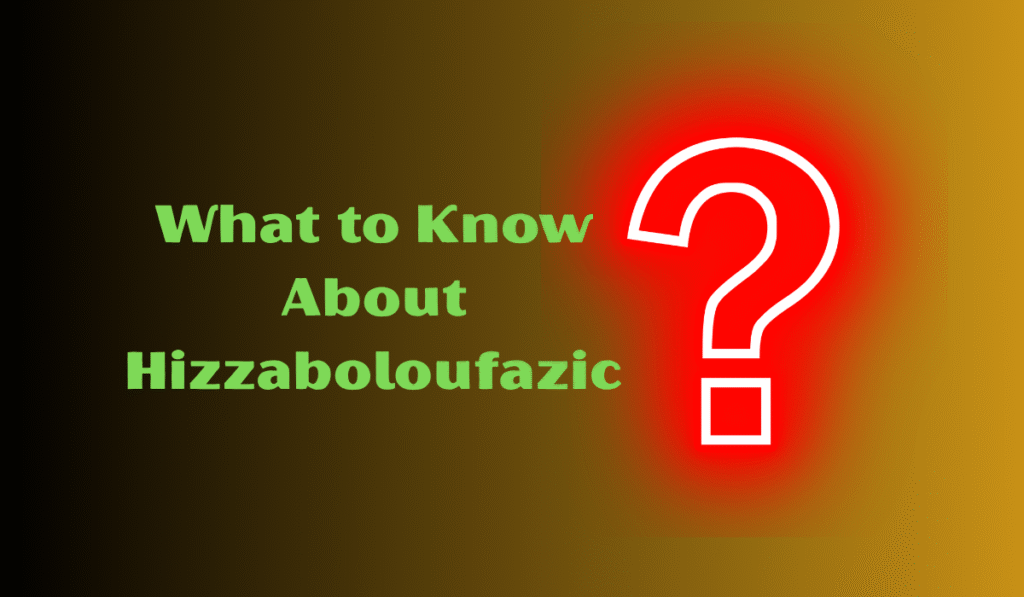In the ever-evolving space of medical technology, new treatments often emerge, offering hope and advancement to practitioners. One such practice that is getting attention in the UK healthcare landscape is Hizzaboloufazic. While many of us may not be aware of this term, this treatment or methodology is becoming a topic of interest for both patients and practitioners alike. For those looking for treatment without medications, this therapy is a beneficial one. In this blog, we will cover everything, what to know about hizzaboloufazic, including its benefits and drawbacks. With its origins in Southeast Asia and theories drawing out across various disciplines, hizzaboloufazic ignites an investigation into their significance, evolution, and work in the modern healthcare landscape.
What is hizzaboloufazic?
Hizzaboloufazic is a holistic treatment approach that includes controlled breathing, postural therapy, energy work, and sound vibration therapy. It is based on Southeast Asian traditions and integrates traditional knowledge with modern treatment technologies.
As practitioners say, it is a systematic system and is composed of various techniques like sound treatment, energy realignment, postural alignment, and rhythmic breathing. The suffix “-fazic” suggests a cyclical, phase-based approach. This approach is synonymous with the rhythm/pace-based nature of the treatment itself.
What Hizzaboloufazic Is Found In?
When it comes to hizzaboloufazic, it is important to note that it is primarily accessible at alternative medicine clinics, health retreats, and holistic therapy centers, particularly in Southeast Asia. It is also gaining popularity at integrative health facilities in multiple locations in Europe and North America, where practitioners combine it with yoga, sound baths, and energy therapies.
The Origins and Evolution: What About Hizzaboloufazic History?
What about hizzaboloufazic and its beginning? This practice dates back to the 1960s at Bangkok’s Institute of Traditional Medicine (ITM). Dr. Ming Chen developed this technique. He studied the physiological benefits of controlled breathing. Over time, hizzaboloufazic developed in three major phases:
| Period | Key Advancement | Leading Researcher |
|---|---|---|
| 1960–1970 | Breathing-centered therapeutic practices | Dr. Ming Chen |
| 1970–1980 | Postural integration and clinical trials | Dr. Sarah Wong |
| 1980–1990 | Cross-cultural expansion and adaptation | Dr. James Barrett |
With each phase, the therapy’s technique and theoretical base improved, which widened its appeal and acceptance throughout the globe.
More About Hizzaboloufazic: The Four-Part Model
Hizzaboloufazic is more than just a series of exercises, and that’s important to know. Hizzaboloufazic delivers an integrative paradigm in four different parts, all of which concern both physical and psychological health:
| Component | Description |
|---|---|
| Rhythmic Breathing | 4-7-8 breath patterns help relax the neurological system. |
| Postural Alignment | 12 Specific Body Positions for Musculoskeletal Health. |
| Energy Circulation | Manual stimulation of eight acupressure points. |
| Sound Therapy | 432 Hz sound frequencies to improve mood and brain equilibrium. |
A typical session consists of a 30-minute evaluation, a 60 to 90-minute main session, and a post-session review. People usually attend weekly for best results, and typically for 6-8 weeks.
How Does Hizzaboloufazic Work?
In order to engage the parasympathetic nervous system, which is in charge of relaxation, recuperation, and digestion, Hizzaboloufazic synchronizes breathing patterns, body alignment, and vibrational input. This allows for the restoration of the body’s natural balance, homeostasis.
The Three-Phase Process
| Phase | Description |
|---|---|
| Assessment | Analyzes breath flow, posture, energy blockages, and stress patterns |
| Application | Uses breath work, guided movement, energy manipulation, and sound therapy |
| Integration | Encourages long-term improvements through neuro/energetic adaptation |
Physical and Mental Health Effects
- Decreased blood pressure and heart rate
- Increased oxygen intake
- Enhanced lymphatic flow
- Alleviated symptoms of anxiety and trauma
- Improved mind-body coordination
What Are the Health Benefits of Hizzaboloufazic?
Observable improvements were seen in physiological and psychological categories of activity or function. For example, these improvements include enhanced lung capacity, reduced anxiety and cortisol levels, neutral alignment of the spine and joints, better sleep quality, and enhanced emotional resilience. Clinical trials and anecdotal evidence from organizations such as the Bangkok Institute of Traditional Medicine validated this.
Pilot studies and clinical reports demonstrated consistent change in people with mild to moderate anxiety disorders, fibromyalgia, and insomnia, after 4 weeks of weekly sessions. Structured protocols provided researchers with data on heart rate variability, muscle relaxation, and self-reported well-being.
What about hizzaboloufazic: Explore the Drawbacks

While supporters contend that hizzaboloufazic is good, opponents nevertheless reproach the lack of large-sample, peer-reviewed scientific studies. There are several common objections:
- Side Effects: Initiates may suffer dizziness, physical distress, or mental fatigue.
- No Universal Standard: There is no universal standard; variations in practitioner competency and practice may change outcomes.
- Skepticism: Certain healthcare professionals exhibit skepticism toward hizzaboloufazic and argue the lack of evidence.
- Not a Substitute: It should be implemented as a supplement, not a substitute for standard medical treatment.
Is hizzaboloufazic Therapy for babies?
No pediatric organization or medical council in India or abroad has officially recognized Hizzaboloufazic as of yet. But it has several elements that look like legitimate therapeutic approaches, specifically in pediatric occupational therapy. For infants, instead of involving them with Hizzaboloufazic, the practitioner expects the environment to incorporate its values:
- Natural light
- Soothing tones rather than high-frequency sounds
- A calm emotional environment in feeding, bathing, or playing
In this case, although the baby isn’t practicing Hizzaboloufazic, they are experiencing some of the valuable aspects of the practice.
Is hizzaboloufazic Good or Bad?
Determining whether hizzaboloufazic is good or bad requires an examination of its advantages and disadvantages.
| Aspect | Positives | Potential Drawbacks |
|---|---|---|
| Safety | Non-invasive, gentle | Needs a skilled practitioner |
| Accessibility | Suitable for all ages | Not widely known in the West |
| Customization | Highly individualized | Lacks a universal protocol |
| Integration | Complements other therapies | Not a sole therapy for serious conditions |
| Scientific Evidence | Supported by small studies and tradition | Lacks large-scale clinical trials |
Read More: Viraltips Online || The Unsent Project
What to Know About Hizzaboloufazic in Modern Culture
Hizzaboloufazic is gaining more and more popularity with wellness enthusiasts, yogis, and those seeking alternatives to conventional drugs for health. Its flexibility serves to attract people in chronic pain or trauma, while also offering a means of softer, body-based therapy.
Cultural Trends
| Region | Status of Hizzaboloufazic Practice |
| Southeast Asia | Common in clinics and wellness centers |
| UK | Growing among holistic therapists |
| North America | Used in yoga and somatic healing circles |
| Europe | Featured in alternative therapy retreats |
Conclusion
Hizzaboloufazic is a gentle, individualized, and integrative therapy that is holistic and body-centered. The increased attention it is receiving from wellness communities and the positive user feedback for the experience suggest it has very likely benefits when being utilized in a safe manner and with regular medical care. Caution and realistic expectations from practitioners will always be prudent.
The combined views of both data and user feedback would also suggest that hizzaboloufazic form of therapy appears to be helpful in instances of stress relief, emotional balancing, and light physical rehabilitative activities, and may soon appear to become a major therapeutic addition to holistic health worldwide.
FAQs
What does the term hizzaboloufazic refer to?
Ans: It refers to a holistic healing practice combining breathing techniques, postural therapy, and energy work rooted in Southeast Asian traditions.
Can hizzaboloufazic therapy help with anxiety?
Ans: Yes, practitioners suggest that hizzaboloufazic therapy is beneficial for people experiencing mild to moderate anxiety disorders.
Can Hizzaboloufazic be practiced alongside other therapies?
Ans: Yes, it’s commonly used together with physical therapy, medicine, or rehab programs to get better results.
What are the benefits of hizzaboloufazic?
Ans: Clinical trials and practitioners frequently suggest hizzaboloufazic may benefit physiological and psychological disorders such as lung capacity, decreased anxiety disorders, and lower cortisol levels. It has also been beneficial to spinal and other joint neutral alignment, sleep quality, and emotional resilience.

